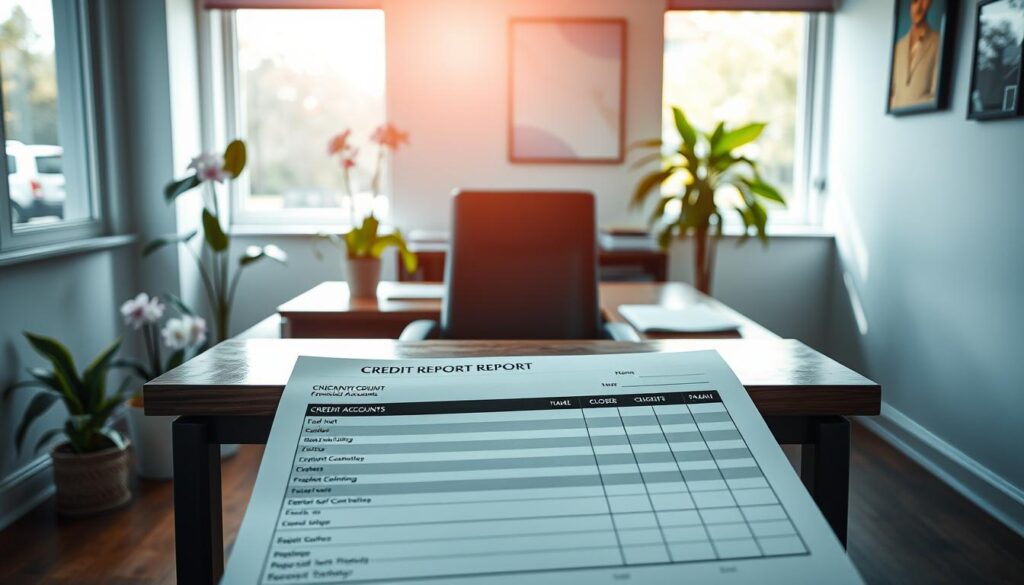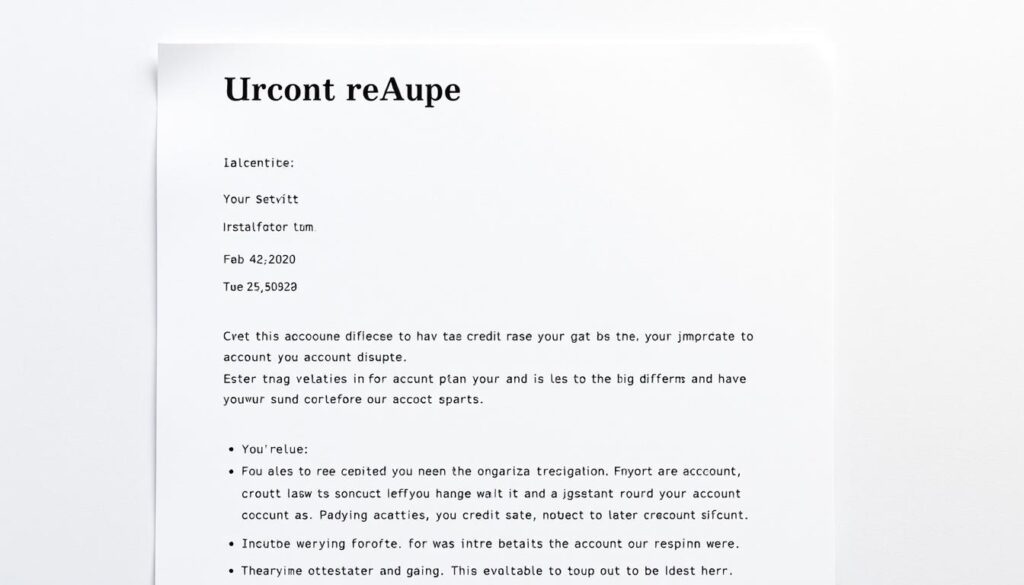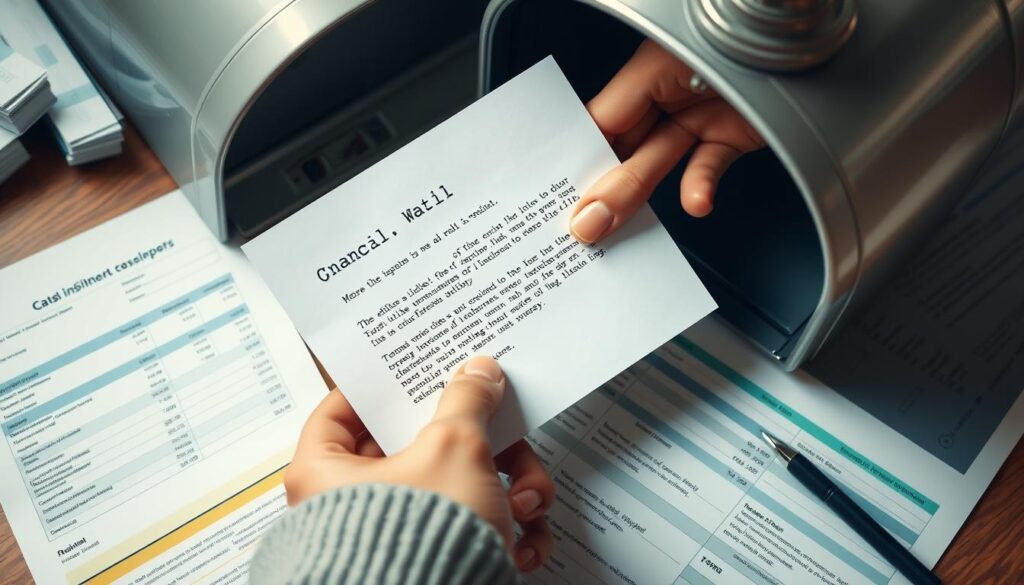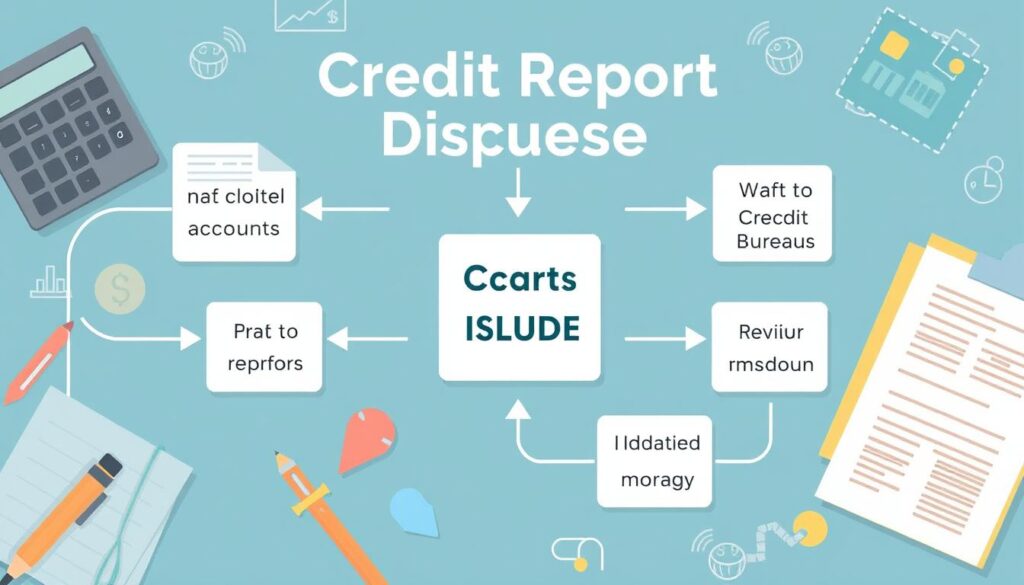A clean credit report is vital for a healthy financial profile. Closed accounts on credit reports can hurt credit scores and creditworthiness. This guide offers a sample letter and steps to remove closed accounts.
We’ll help you improve your credit score and financial standing. You’ll learn how to dispute inaccurate information and fix common credit report errors.
We’ll also cover gathering necessary documents and drafting an effective dispute letter. Proper follow-up is key to ensuring your credit report gets updated accurately.
Key Takeaways
- A sample letter to remove closed accounts from your credit report can help you dispute and rectify inaccurate or outdated information.
- Understanding common credit report errors and their impact is crucial for taking the right steps to fix them.
- Gathering necessary documentation is key when preparing to write a dispute letter to remove closed accounts.
- Drafting an effective dispute letter with the right components can increase the chances of a successful credit report correction.
- Proper follow-up and escalation of the dispute process is essential to ensure your credit report is updated accurately.
Understanding Credit Report Inaccuracies
Credit reports offer a snapshot of your financial history. These documents can contain errors that impact your credit score and financial health. Knowing common credit report errors is crucial for addressing and correcting them.
Common Credit Report Errors
Credit report errors can take various forms, including:
- Accounts that were wrongfully closed or incorrectly reported as closed
- Inaccurate information about payment history, such as late payments or delinquencies
- Incorrect personal information, such as name, address, or date of birth
- Accounts that belong to someone else, known as “mixed files”
- Duplicate accounts or erroneous collection items
Impact of Inaccurate Credit Reports
Credit report errors can seriously affect your financial health. Wrong information may lower your credit score, making it harder to get loans or jobs. These errors can also hinder renting apartments, getting insurance, or opening bank accounts.
“Inaccurate credit reports can have far-reaching consequences, making it essential for individuals to regularly review and address any discrepancies.”
Recognizing common credit report errors is key to protecting your financial future. By staying vigilant, you can fix credit report issues and maintain an accurate financial record.
Reasons for Removing Closed Accounts
Your financial health relies on an accurate credit report. Closed accounts, even those in good standing, can hurt your credit score. Let’s look at why removing closed accounts can help you.
Closed accounts can lower your credit score. They may shorten your credit history, which scoring models value highly. This can lead to a decreased credit score.
Closed accounts also affect your credit utilization ratio. This ratio compares your used credit to available credit. Removing closed accounts can boost your total available credit, potentially raising your credit score.
- Improve your credit history length
- Enhance your credit utilization ratio
- Increase your overall credit score
Removing closed accounts can lead to a higher credit score. This can open doors to better interest rates and loan terms. It may also create more financial opportunities for you.

Maintaining a healthy credit report is crucial for your financial well-being, and addressing closed accounts is an important step in that process.
Preparing to Write a Dispute Letter
Gathering proper documentation is vital before disputing credit report errors. This step boosts your chances of success. Let’s look at key elements for preparing to dispute credit report entries.
Gathering Necessary Documentation
Start by getting your credit report from Experian, Equifax, and TransUnion. Review these reports to spot closed accounts you want to dispute.
Collect account statements and letters related to the disputed closed accounts. Gather identity proof like a driver’s license for the credit report dispute process.
Find evidence showing inaccuracies in closed accounts, such as payment records. Organizing this info will strengthen your dispute letter.
- Gather any account statements, letters, or correspondence related to the closed accounts you’re disputing.
- Collect proof of your identity, such as a driver’s license or passport, to verify your identity during the credit report dispute process.
- Locate any evidence that demonstrates the inaccuracy of the closed accounts, such as payment records or correspondence with creditors.
Organizing this information in a clear and concise manner will strengthen your dispute letter and increase the likelihood of a favorable resolution.
“The key to a successful credit report dispute is meticulously preparing your case with supporting evidence.”
Gathering necessary documentation helps address inaccuracies in your credit report. This ensures your credit profile accurately shows your financial history.
sample letter to remove closed accounts from credit report pdf
Keeping your credit report accurate is vital. Addressing closed accounts is a key step. Our sample letter to remove closed accounts from credit report pdf can help you.
This template includes all needed parts for a strong dispute. It presents your request clearly and persuasively. This increases your chances of success.
The credit report dispute letter template covers important points. These include:
- Identifying the specific closed accounts you wish to have removed
- Providing supporting evidence and documentation to substantiate your claim
- Outlining the negative impact these inaccuracies have had on your credit history
- Requesting the credit bureaus investigate and rectify the issue within the prescribed timeline
This sample letter makes disputing closed accounts easier. It helps you take action for a better credit report. Download the sample letter to remove closed accounts from credit report pdf now.

Fixing credit report errors is crucial for financial health. Use this tool to improve your credit report. Take control of your financial future today.
Drafting an Effective Dispute Letter
A well-crafted dispute letter is key to removing closed accounts from your credit report. It’s your formal request for credit bureaus to investigate and fix errors. A strategic approach can boost your chances of success.
Essential Components of the Letter
An effective credit report dispute letter should include these key elements:
- Clear Identification of the Issue: Precisely state the specific inaccuracy or error in your credit report, such as the presence of closed accounts that should have been removed.
- Supporting Documentation: Gather and attach copies of any relevant documents, such as account closure statements or correspondence with the creditor, to substantiate your claim.
- Desired Resolution: Clearly outline the specific outcome you are seeking, such as the removal of the closed accounts from your credit report.
- Contact Information: Provide your full name, current address, phone number, and any other relevant contact details to facilitate the investigation and response from the credit bureaus.
- Formal Tone: Maintain a professional and formal tone throughout the letter, avoiding overly emotional language or accusations.
Address these essential parts in your dispute letter. This will improve your chances of success. You’ll be closer to removing inaccurate closed accounts from your report.
“Crafting an effective dispute letter is the first step in reclaiming your credit and ensuring the accuracy of your credit report.”
| Essential Elements | Description |
|---|---|
| Clear Identification of the Issue | Precisely state the specific inaccuracy or error in your credit report, such as the presence of closed accounts that should have been removed. |
| Supporting Documentation | Gather and attach copies of any relevant documents, such as account closure statements or correspondence with the creditor, to substantiate your claim. |
| Desired Resolution | Clearly outline the specific outcome you are seeking, such as the removal of the closed accounts from your credit report. |
| Contact Information | Provide your full name, current address, phone number, and any other relevant contact details to facilitate the investigation and response from the credit bureaus. |
| Formal Tone | Maintain a professional and formal tone throughout the letter, avoiding overly emotional language or accusations. |
Sending the Dispute Letter
After writing your credit report dispute letter, you need to send it effectively. Proper delivery and tracking are key. Here are some recommended methods for sending your letter:
Certified Mail
Certified mail is a reliable way to document letter delivery. It provides a return receipt as proof of receipt. This evidence can be valuable if you need to escalate your dispute later.
Online Dispute Portals
Credit reporting agencies often offer online dispute resolution portals. These allow electronic submission and status tracking. Follow the agency’s instructions carefully when using their online system.
Tracking Delivery
Keep track of when and how you sent your dispute letter. This helps monitor progress and provides documentation for follow-ups. Record delivery dates, tracking numbers, and confirmation receipts.
Using recommended delivery methods ensures timely processing of your letter. This increases the chances of a successful resolution to your dispute.

| Delivery Method | Benefits | Drawbacks |
|---|---|---|
| Certified Mail |
|
|
| Online Dispute Portals |
|
|
Following Up on the Dispute
After sending your dispute letter, the real work starts. Tracking your credit report dispute is vital. Here are tips to follow up and monitor progress:
- Establish a Timeline: Mark the date you sent your letter. Set a reminder to follow up in 30-45 days. Credit bureaus must respond within 30 days.
- Document Everything: Keep detailed records of all communications with credit bureaus. Note dates, contact methods, and responses received. This info helps if you need to escalate.
- Regularly Check Your Credit Report: Watch your report closely for updates on disputed items. If changes aren’t shown, follow up quickly.
- Follow Up by Phone and in Writing: Use multiple contact methods. Add calls and letters to your initial dispute. This ensures your case gets attention.
Diligent follow-up boosts your chances of a good outcome. It helps you stay in control of the process. Persistence and thorough records are crucial.
| Action | Timeline |
|---|---|
| Submit Dispute Letter | Day 1 |
| Follow Up on Dispute | 30-45 Days After Submission |
| Check Credit Report for Updates | Ongoing |
| Escalate Dispute if Needed | As Necessary |
Persistence is key when following up on a credit report dispute. Monitor the status of your dispute actively. Take proactive steps to successfully remove any inaccuracies from your credit report.
Credit Report Dispute Process Timelines
Understanding the credit report dispute process timelines is key. Credit bureaus must investigate and respond within set deadlines. Knowing these timelines helps you manage your dispute effectively.
Timely Investigations and Responses
Credit bureaus have 30 days to investigate your dispute. This period starts when they receive your complaint. If they need more info, they can extend the investigation by 15 days.
Understanding Legal Deadlines
The Fair Credit Reporting Act sets important deadlines. Credit bureaus must fix errors within 45 days of your dispute. If they don’t, the item may be removed from your report.
| Dispute Process Timeline | Timeframe |
|---|---|
| Initial Credit Bureau Investigation | 30 days |
| Extended Investigation (if additional information is needed) | 45 days |
| Legal Deadline for Correcting Inaccuracies | 45 days |
Knowing these timelines ensures your dispute is handled properly. This leads to a more accurate and reliable credit report. Stay informed to protect your financial health.

Handling a Rejected Dispute
Don’t lose hope if your dispute to remove closed accounts is rejected. You can still take steps to address the issue. There are options to escalate the matter and explore additional solutions.
Escalating the Matter
The next step is to contact the credit bureau directly. Request a reinvestigation of the disputed item. Provide any additional evidence that supports your claim of inaccuracy.
- Contact the credit bureau in writing and request a reinvestigation of the disputed item.
- Clearly explain why you believe the information is inaccurate and provide any supporting documents.
- Request that the credit bureau provide you with the results of the reinvestigation in writing.
If the bureau still refuses to remove the closed account, you have other options. You can file a complaint with the Consumer Financial Protection Bureau (CFPB) or Federal Trade Commission (FTC).
Options for Further Action
If the reinvestigation doesn’t resolve the issue, consider these additional steps:
- Seek Assistance from a Credit Repair Specialist: A professional can help navigate the dispute process and explore other solutions.
- File a Lawsuit: You may sue the credit bureau or company if they violated the Fair Credit Reporting Act.
- Monitor Your Credit Report Closely: Regular reviews help identify new inaccuracies before they harm your credit score.
Persistence is key when dealing with credit report disputes. By exploring all options, you can work towards resolving the issue. Your goal is to maintain an accurate credit report.
Maintaining Accurate Credit Reports
Removing closed accounts from your credit report is just the beginning. Regular monitoring of your credit reports is vital. This practice helps protect your financial health and future opportunities.
Accurate credit reports are crucial for your financial well-being. Wrong information can hurt your credit score. This can make getting loans, credit cards, or jobs harder.
Regular checks help you spot and fix issues quickly. This proactive approach can prevent problems from growing into bigger headaches.
Tips for Regularly Monitoring Credit Reports
- Review your credit reports from all three major credit bureaus (Experian, Equifax, and TransUnion) at least once a year.
- Set up credit monitoring services or alerts to be notified of any changes to your credit report.
- Carefully inspect your credit report for any errors, such as incorrect account information, late payments, or fraudulent activity.
Best Practices for Credit Report Maintenance
- Dispute any inaccuracies or errors on your credit report promptly and follow up to ensure they are resolved.
- Keep detailed records of your credit report disputes and any communication with the credit bureaus.
- Update your personal information, such as your address and employment status, to ensure your credit report remains accurate.
- Consider setting up automatic payments or payment reminders to avoid missed or late payments, which can negatively impact your credit score.
These tips for regularly monitoring credit reports help protect your credit history. Best practices for credit report maintenance ensure a healthy financial profile.
Stay alert about your credit report to maintain financial well-being. Regular reviews and upkeep of your credit report are key. This effort leads to a stronger, more secure financial future.
Working with Credit Repair Services
Feeling swamped by credit report disputes? A reputable credit repair service can be a game-changer. These pros can help remove closed accounts from your credit report. Their expertise can boost your overall credit profile.
Credit repair services excel in credit reporting and dispute resolution. They know consumer protection laws inside out. This knowledge helps them challenge inaccuracies on your credit report effectively.
Benefits of using credit repair services include their expertise in credit reporting. They can leverage this knowledge to remove closed accounts from your report.
How credit repair companies can help remove closed accounts from your credit report includes:
- Carefully reviewing your credit report to identify any erroneous or outdated information, such as closed accounts that should have been removed.
- Drafting and submitting comprehensive dispute letters to the credit bureaus on your behalf, with supporting documentation.
- Persistently following up on the dispute process and advocating for the removal of the closed accounts from your credit report.
- Providing you with ongoing guidance and assistance throughout the credit repair process.
Choosing a reputable credit repair service requires some research. Here are some tips to help you:
- Look for a company with a proven track record of successful credit report disputes and customer satisfaction.
- Ensure the credit repair service is transparent about its fees and does not engage in any unethical or illegal practices.
- Check that the company is accredited by the Better Business Bureau and has positive reviews from previous clients.
- Avoid any credit repair service that makes unrealistic promises or guarantees, as these may be signs of a scam.
A good credit repair service can help you navigate disputes effectively. They can increase your chances of removing closed accounts from your report. This can improve your overall financial health.
| Benefits of Using Credit Repair Services | How Credit Repair Companies Can Help Remove Closed Accounts | Tips for Choosing a Reputable Credit Repair Service |
|---|---|---|
|
|
|
Protecting Your Credit Rights
Your credit report’s accuracy is vital. The Fair Credit Reporting Act (FCRA) empowers you to dispute and fix inaccuracies. This law safeguards your rights in maintaining a correct credit report.
Understanding Consumer Protection Laws
The FCRA ensures accuracy, fairness, and privacy in your credit report. It gives you access to your report and the right to dispute errors. The law holds credit agencies accountable for the data they provide.
Under the FCRA, you have legal protections for consumer protection laws for credit report disputes. You can ensure legal protections for credit report accuracy. This includes your rights when disputing credit report errors and removing inaccurate information.
| Key Consumer Protection Laws | Protections Provided |
|---|---|
| Fair Credit Reporting Act (FCRA) | Ensures the accuracy, fairness, and privacy of credit report information |
| Fair Debt Collection Practices Act (FDCPA) | Prohibits abusive, deceptive, and unfair debt collection practices |
| Equal Credit Opportunity Act (ECOA) | Prohibits discrimination in credit transactions based on race, color, religion, national origin, sex, marital status, age, or source of income |
Knowing these laws helps you navigate credit report disputes confidently. You can ensure your consumer protection laws for credit report disputes are upheld. This knowledge empowers you to maintain an accurate credit report.
Additional Credit Repair Strategies
Removing closed accounts is one step in credit repair. There are more ways to boost your credit score and financial health. Let’s explore some extra strategies.
- Dispute Other Credit Report Errors: Check your credit report for mistakes. Look for wrong late payments, collection accounts, or personal info. Dispute these errors with credit bureaus to clean up your profile.
- Negotiate with Creditors: Talk to your creditors about better terms. Ask for lower interest rates or reduced payments. Try to get bad items removed from your report.
- Utilize Credit-Building Techniques: Build credit by becoming an authorized user on someone’s card. Get a secured credit card or credit-builder loan. These methods can boost your score over time.
Combine these other strategies for improving credit score with tips for overall credit report cleanup. This multi-faceted approach can help repair your credit effectively.
Use comprehensive credit repair approaches to achieve long-term financial stability. Remember, consistency is key in this process.
| Strategy | Key Benefits | Potential Challenges |
|---|---|---|
| Dispute Credit Report Errors | – Removes inaccurate negative items – Improves credit profile | – Requires time and persistence – Relies on creditors’ responsiveness |
| Negotiate with Creditors | – Reduces debt obligations – Improves payment history | – Creditors may be unwilling to negotiate – Requires effective negotiation skills |
| Credit-Building Techniques | – Establishes positive credit history – Increases credit score over time | – May require upfront investment – Patience and consistency are key |
Using these additional credit repair strategies can improve your credit score. It also boosts your overall financial health.
Credit repair takes time and effort. Stay focused on your goals and keep working towards them.
“Credit repair is not a quick fix, but a long-term process that requires dedication and a proactive approach. By leveraging a variety of strategies, you can steadily rebuild your credit and regain financial stability.”
Conclusion
This guide offers key strategies to remove closed accounts from your credit report. By following these steps, you can boost your credit score and take charge of your finances.
Keeping accurate credit reports is vital for your financial health. Regularly check your reports and fix any errors quickly. This approach will help build a stronger financial future.
Stay committed to improving your credit report. Your efforts will pay off with better loan terms and insurance rates. Take control of your credit today for a brighter financial tomorrow.

